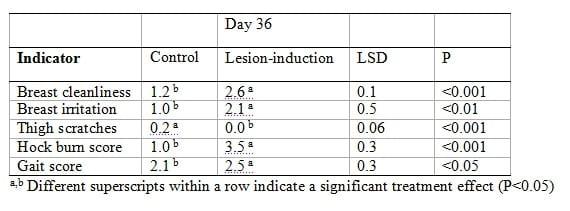Wet litter not only induces footpad dermatitis but also reduces overall welfare, technical performance and carcass yields in broiler chickens
In an experimental set-up the results of broilers housed on wet litter and having a high prevalence of FPD (W, N=4 groups of 900 birds) were compared with results of the control (C; N=4 groups of 900 birds) groups kept on litter of good quality and having a low prevalence of FPD. For the W treatment the litter moisture content was increased by systematically spraying water over the litter from day 6 of age onwards. Broilers kept on wet litter had a significantly lower body weight gain, feed intake and water intake and a significantly higher feed conversion ratio compared with broilers of the control group (P<0.05). Broilers kept on wet litter had had more rejections of the commercial parts. Broilers kept on wet litter had also significantly more foot pad lesions, hock burns and breast irritations (P<0.001), were more dirty (P<0.001) but had less thigh scratches (P<0.001) compared with the C groups. In addition, they had a higher gait score indicating a worse locomotion at day 36 compared with the C groups (P<0.05). In conclusion, increased litter moisture content not only caused severe FPD but also reduced broiler performance and carcass yields and had a negative effect on other welfare aspects.
Key words: broiler, carcass yield, performance, animal welfare, footpad dermatitis
- Induction of footpad dermatitis in broiler chickens by experimentally increasing the litter moisture content is accompanied by reduced technical performance, welfare and more rejections of commercial parts at the slaughter house as compared control groups of broilers kept on dry litter without severe footpad dermatitis;
- Prevention of footpad lesions in broilers is therefore not only preferred from a welfare point of view but also from an economic point of view. Not only because footpad lesions have an economic value in itself but also because the negative associations with technical performance and downgraded carcass quality.
- Allain, V., Mirabito, L., Arnould, C., Colas, M., Le Bouquin, S., Lupo, C., Michel, V. (2009). Skin lesions in broiler chickens measured at the slaughterhouse: relationships between lesions and between their prevalence and rearing factors. British Poultry Science 50:407-417.
- Alvino, G. M., Archer, G. S., Mench, J. A. (2009). Behavioural time budgets of broiler chickens reared in varying light intensities. Applied Animimal Behaviour Science 118:54-61.
- Greene, J. A., McCracken, R. M., Evans, R. T. (1985). A contact dermatitis of broilers – clinical and pathological findings. Avian Pathology 14:23-38.
- Haslam, S. M., Knowles, T. G., Brown, S. N., Wilkins, L. J., Kestin, S. C., Warriss, P. D., Nicol, C.J. (2007). Factors affecting the prevalence of foot pad dermatitis, hock burn and breast burn in broiler chicken. British Poultry Science 48:264-275.
- Martland, M. F. (1984). Wet litter as a cause of plantar pododermatitis, leading to foot ulcerration and lameness in fattening turkeys. Avian Pathology 1984 13:241-252.
- Martland, M. F. (1985). Ulcerative dermatitis in broiler-chickens – the effect of wet litter. Avian Pathology 14:353-364.
- Shepherd, E. M., Fairchild, B. D. (2010). Footpad dermatitis in poultry. Poult. Sci. 89:2043-51.



Dear Winfridus Bakker,
We did not specifically look for toe abnormalities. We looked for the gait and FPD, hock burns. I can’t remember if there were more toe abnormalities than normal (if there were any).
The wet litter leaded also to burn spot on the toes. But to our opinion the lower gait was caused by the severity of the footpad lesions and probably also by the severe hock burns
Dear Dr. Mingan Choct,
FPD and thus wet litter is a major issue in the EU. A recent study in the Netherlands (De Jong et al, 2011) showed that 38.4% of the regular (fast growing) broilers had severe lesions. Studies in France (Allain, 2009) and Portugal (Gouveia et al, 2009) reported levels of about 70% severe FPD. But there are also countries such as Sweden and Denmark (these countries uses for several years now a monitoring program were FPD is an indicator of the welfare of broiler flocks) were the incidence of severe FPD is low (<10%).
FPD is caused by wet litter (wet, sticky and caked litter increases the prevalence of FPD!). So, the best way to prevent FPD is to keep the litter dry and friable, especially in the brooding period (first 14 – 18 days) when the birds appear to be more susceptible to lesion development. In my opinion, farm management is the major cause of wet litter. By farm management you can think of litter (litter material and litter depth), light (distribution of light, light colour and lighting programme), water (supply and water management), ventilation (rate) and heating (heat distribution, heat source), stocking density and breed. But also feed and diseases played an important role.
I like to know if due to wet litter more toe defects were observed like crooked toes and the like. Because the gait score was affected, was this a consequence of footpath lesions or were there more leg abnormalities like Valgus and Varus defects?
Hi Dr van Harn,
Is wet litter a major problem in Europe? In your experience, what are the key predisposing factors for it?
Best wishes, Mingan Choct














.jpg&w=3840&q=75)